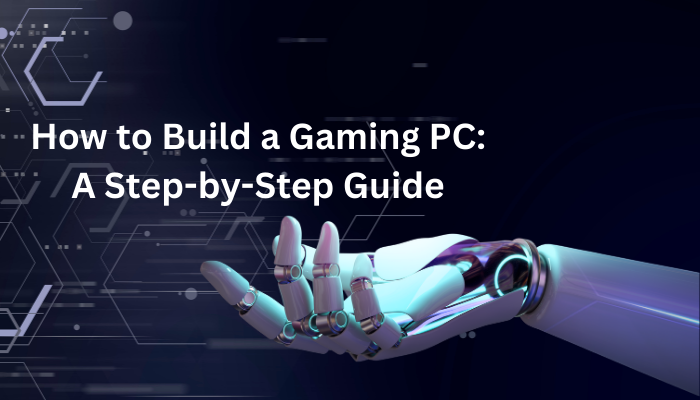Building your own gaming PC can be an incredibly rewarding experience, offering you a customized system tailored to your exact gaming needs. Whether you’re looking to save money, enjoy better performance, or just want the satisfaction of building something yourself, constructing a gaming PC from scratch is the way to go. In this step-by-step guide, we’ll walk you through the process of building a gaming PC, from selecting the right components to assembling them and installing your operating system.

1. Planning Your Build
Before you start buying parts, it’s essential to plan your build. This involves setting a budget, determining your gaming goals, and researching the components you’ll need.
- Set a Budget:
- Determine how much you’re willing to spend on your gaming PC. A budget will help you choose the right components without overspending.
- Entry-level gaming PCs can start around $600-$800, while mid-range builds may cost between $1,000-$1,500. High-end gaming rigs can go beyond $2,000.
- Define Your Gaming Goals:
- Consider what types of games you’ll be playing and at what resolution and settings. For example, 1080p gaming requires less power than 4K gaming.
- Determine if you’ll be using your PC for other tasks like streaming, video editing, or VR gaming.
- Research Components:
- Make a list of the components you’ll need, including the CPU, GPU, motherboard, RAM, storage, power supply, case, and cooling system.
- Read reviews and check compatibility to ensure all parts will work together.
2. Choosing Your Components
Selecting the right components is crucial to building a gaming PC that performs well and meets your needs.
- Central Processing Unit (CPU):
- The CPU is the brain of your PC. Choose a processor that balances performance and cost, such as the Intel Core i5/i7 or AMD Ryzen 5/7 series.
- Ensure the CPU is compatible with your motherboard.
- Graphics Processing Unit (GPU):
- The GPU is the most critical component for gaming performance. Nvidia’s GeForce RTX series and AMD’s Radeon RX series are popular choices.
- Consider the games you play and the resolution you want to achieve when selecting a GPU.
- Motherboard:
- The motherboard connects all your components. Ensure it has the right socket for your CPU and supports your chosen RAM, storage, and GPU.
- Features like Wi-Fi, Bluetooth, and multiple USB ports can also be considered.
- Memory (RAM):
- 16GB of DDR4 RAM is the sweet spot for most gaming PCs. However, 32GB is recommended for future-proofing or multitasking.
- Ensure the RAM is compatible with your motherboard and runs at the desired speed.
- Storage:
- Choose an SSD (Solid State Drive) for faster load times and overall system responsiveness. A 500GB or 1TB NVMe SSD is ideal for the operating system and games.
- You can add a larger HDD (Hard Disk Drive) for additional storage if needed.
- Power Supply Unit (PSU):
- The PSU powers your entire system. Choose a reliable PSU with enough wattage to support all your components. 500W-750W is typical for most gaming builds.
- Opt for a PSU with an 80 PLUS certification for efficiency.
- Case:
- The case houses all your components. Choose one that fits your motherboard size (ATX, microATX, mini-ITX) and has good airflow.
- Consider aesthetics, including RGB lighting, tempered glass panels, and cable management options.
- Cooling System:
- Proper cooling is essential for maintaining performance. Most CPUs come with a stock cooler, but aftermarket coolers or liquid cooling systems can offer better performance and quieter operation.
- Ensure your case has adequate ventilation and space for additional fans if needed.
3. Assembling Your PC
With all your components ready, it’s time to assemble your gaming PC. Follow these steps carefully to ensure everything is connected correctly.
- Step 1: Prepare Your Workspace
- Work on a clean, flat surface in a static-free environment. Gather all your tools, such as a screwdriver, and organize your components.
- Step 2: Install the CPU
- Open the CPU socket on the motherboard by lifting the retention arm.
- Align the CPU with the socket (match the triangle on the CPU with the one on the socket) and gently place it in. Lower the retention arm to secure the CPU.
- Step 3: Install the CPU Cooler
- If using the stock cooler, attach it directly to the CPU with the pre-applied thermal paste.
- If using an aftermarket cooler, apply a small amount of thermal paste to the CPU, then secure the cooler according to the manufacturer’s instructions.
- Step 4: Install the RAM
- Open the RAM slots on the motherboard. Align the notch on the RAM stick with the one on the slot, then press down firmly until the clips snap into place.
- Step 5: Install the Motherboard
- Place the motherboard inside the case, aligning it with the standoffs and I/O shield.
- Secure the motherboard with screws, ensuring it’s firmly attached to the case.
- Step 6: Install the Power Supply
- Slide the PSU into its designated spot in the case, typically at the bottom or top rear.
- Secure it with screws and connect the necessary power cables to the motherboard, GPU, and storage devices.
- Step 7: Install the Storage
- For an SSD, mount it in a dedicated slot or bay, then connect it to the motherboard using a SATA or NVMe connection.
- If using an HDD, mount it in the drive bay and connect it similarly.
- Step 8: Install the GPU
- Insert the GPU into the PCIe slot on the motherboard, usually the topmost one.
- Secure the GPU to the case with screws and connect the necessary power cables from the PSU.
- Step 9: Connect the Cables
- Connect all necessary cables, including the front panel connectors (power button, USB ports), fans, and any additional peripherals.
- Organize the cables for better airflow and aesthetics.
- Step 10: Power On and Test
- Double-check all connections, then plug in the power cable and turn on your PC.
- Enter the BIOS to ensure the system recognizes all components. Adjust settings like RAM speed if needed.
4. Installing the Operating System and Drivers
With your PC assembled, it’s time to install the operating system and necessary drivers.
- Step 1: Install the Operating System
- Insert your bootable USB drive with the OS (like Windows 10/11) and power on the PC.
- Follow the on-screen instructions to install the OS on your SSD or preferred storage device.
- Step 2: Install Drivers
- Once the OS is installed, download and install the latest drivers for your GPU, motherboard, and other components.
- Use the manufacturer’s websites to ensure you’re getting the most up-to-date drivers.
- Step 3: Install Gaming Software
- Install your preferred gaming platform (Steam, Epic Games Store, etc.) and start downloading your favorite games.
5. Final Touches and Optimization
Your gaming PC is almost ready, but a few final touches can optimize performance and ensure long-term reliability.
- Overclocking:
- If you’re comfortable, you can overclock your CPU and GPU for additional performance. Be sure to monitor temperatures to avoid overheating.
- System Monitoring:
- Use software like MSI Afterburner or HWMonitor to keep an eye on your system’s performance, temperatures, and fan speeds.
- Backup and Maintenance:
- Set up regular backups for your important files and games. Keep your system clean and dust-free to maintain optimal performance.
Conclusion
Building a gaming PC can be a fun and educational experience that results in a powerful machine tailored to your specific gaming needs. By carefully selecting your components, following assembly instructions, and optimizing your setup, you’ll enjoy a gaming experience that surpasses what you can achieve with a pre-built system. Whether you’re a seasoned builder or a first-timer, this guide will help you create a gaming PC that’s ready to handle the latest titles and more.
Stay tuned to our blog for more gaming tips, hardware reviews, and tech insights!

